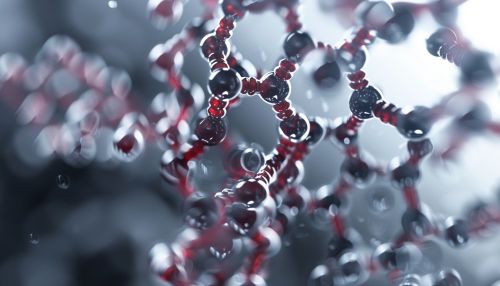Uridine triphosphate: Difference between revisions
(Created page with "== Overview == Uridine triphosphate (UTP) is a nucleotide that is used as a substrate for the synthesis of RNA during the process of transcription. It is also a precursor for the synthesis of cytidine triphosphate (CTP), which is another important component in RNA synthesis. UTP is one of the four main nucleosides found in RNA, the others being adenosine triphosphate (ATP), Gua...") |
No edit summary |
||
| (One intermediate revision by the same user not shown) | |||
| Line 2: | Line 2: | ||
[[Uridine triphosphate]] (UTP) is a [[nucleotide]] that is used as a substrate for the synthesis of [[RNA]] during the process of [[transcription (biology)|transcription]]. It is also a precursor for the synthesis of [[Cytidine triphosphate|cytidine triphosphate]] (CTP), which is another important component in RNA synthesis. UTP is one of the four main nucleosides found in RNA, the others being [[Adenosine triphosphate|adenosine triphosphate]] (ATP), [[Guanosine triphosphate|guanosine triphosphate]] (GTP), and CTP. | [[Uridine triphosphate]] (UTP) is a [[nucleotide]] that is used as a substrate for the synthesis of [[RNA]] during the process of [[transcription (biology)|transcription]]. It is also a precursor for the synthesis of [[Cytidine triphosphate|cytidine triphosphate]] (CTP), which is another important component in RNA synthesis. UTP is one of the four main nucleosides found in RNA, the others being [[Adenosine triphosphate|adenosine triphosphate]] (ATP), [[Guanosine triphosphate|guanosine triphosphate]] (GTP), and CTP. | ||
[[Image:Detail-77723.jpg|thumb|center|A close-up view of the molecular structure of Uridine triphosphate.|class=only_on_mobile]] | |||
[[Image:Detail-77724.jpg|thumb|center|A close-up view of the molecular structure of Uridine triphosphate.|class=only_on_desktop]] | |||
== Structure == | == Structure == | ||
Latest revision as of 10:46, 7 May 2024
Overview
Uridine triphosphate (UTP) is a nucleotide that is used as a substrate for the synthesis of RNA during the process of transcription. It is also a precursor for the synthesis of cytidine triphosphate (CTP), which is another important component in RNA synthesis. UTP is one of the four main nucleosides found in RNA, the others being adenosine triphosphate (ATP), guanosine triphosphate (GTP), and CTP.


Structure
UTP consists of the pyrimidine base uracil attached to the 1' carbon of the ribose sugar, and three phosphate groups attached to the 5' carbon of the ribose. The phosphate groups are linked to each other by phosphoanhydride bonds, which are high-energy bonds that release energy when hydrolyzed. This energy is used to drive various biological processes, including the synthesis of RNA.
Synthesis
The synthesis of UTP begins with the formation of uridine monophosphate (UMP) from orotic acid in a process known as pyrimidine biosynthesis. UMP is then converted to uridine diphosphate (UDP) by the enzyme nucleoside monophosphate kinase, which transfers a phosphate group from ATP to UMP. UDP is then converted to UTP by the enzyme nucleoside diphosphate kinase, which transfers a phosphate group from ATP to UDP.
Function
UTP is primarily used as a substrate for the synthesis of RNA during transcription. During this process, the enzyme RNA polymerase uses UTP as a substrate to add uracil bases to the growing RNA chain. The energy for this process comes from the hydrolysis of the high-energy phosphoanhydride bonds in UTP.
In addition to its role in RNA synthesis, UTP is also used as a precursor for the synthesis of CTP. The enzyme CTP synthetase converts UTP to CTP by adding an amino group to the uracil base. This reaction is important because CTP is used as a substrate for RNA synthesis, and also for the synthesis of phospholipids, which are a major component of cell membranes.
